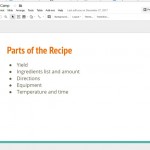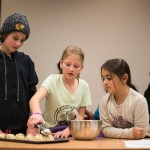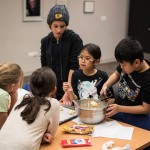As we’ve posted before, school breaks tend to include multi-day programs for grades 3-5. We previously challenged participants to choreograph a robot dance party and extract their own DNA. This past winter break featured a two day program about the science of baking. Each day covered science concepts related to the recipes we tested. And the best part: participants ate their experiment products!
We should note that we have approval from our village’s health department to provide food related programs. Our library is equipped with a kitchen and participants were making the food item themselves rather than staff. Before exploring food related programming at your library, we suggest checking in with your local health department and administration.
Here’s a closer look at what did for this latest boot camp.
 We had two main staff members leading the program with a program assistant on hand to help field questions and tackle clean up. Our participation max was set at 12 and participants were placed in teams of three. At the front of the room, we had the ingredients table and we used a slide presentation to assist in covering the scientific content. The three staff members easily floated between the teams’ tables to help troubleshoot, although we were really impressed with the peer leadership seen in this program.
We had two main staff members leading the program with a program assistant on hand to help field questions and tackle clean up. Our participation max was set at 12 and participants were placed in teams of three. At the front of the room, we had the ingredients table and we used a slide presentation to assist in covering the scientific content. The three staff members easily floated between the teams’ tables to help troubleshoot, although we were really impressed with the peer leadership seen in this program.
Day 1: We began the program by defining chemistry and discussed how in cooking and baking, matter is transformed. We provided examples of baking a cake and making Jell-O so we could emphasize the three states of matter and how each ingredient or component of the recipe contributed to the transformation. Then we went over how to read a recipe, comparing a recipe card to a scientific experiment. We ask participants to help identify parts of the recipe, like yield, ingredients, directions, and equipment, before exploring these parts a little bit more.
 Once these fundamentals were explored, we moved on to the hands on portion of the day. Each team used the same recipe for scones. Program leaders asked teams to assign roles to ensure active and equitable participation. Each team had one designated recipe person who was in charge of reading and making sure the recipe was followed. The other two participants took turns measuring ingredients, stirring, etc. with the recipe person alongside them to verify everything. Once ready, we baked the scones.
Once these fundamentals were explored, we moved on to the hands on portion of the day. Each team used the same recipe for scones. Program leaders asked teams to assign roles to ensure active and equitable participation. Each team had one designated recipe person who was in charge of reading and making sure the recipe was followed. The other two participants took turns measuring ingredients, stirring, etc. with the recipe person alongside them to verify everything. Once ready, we baked the scones.
While the scones were baking, facilitators lead a group exploration with a basic white bread recipe. Here, we talked about leavening dough with yeast and explained that because this was a longer chemical process, we wouldn’t be able to taste the bread until Day 2. As participants tasted their freshly baked scones, we asked them to remember the crumbs and compare to the bread we’d bake later that day.
Day 2: We touched base with participants and asked if anyone had questions from Day 1. Some reported that they went home and made more scones with their family! We then passed out pieces of the basic white bread baked the day before and asked participants to share their observations about the differences in texture, taste, and crumbs between the bread and scones. Then we moved on to talk about scaling recipes and practiced the simple math involved with this. Following that, we jumped right in to the day’s baking challenge: chocolate chip cookies.
 Each table received a modified version of a chocolate chip cookie recipe. We had the table confirm what was different about their recipe with the group: baking soda only, baking powder only, baking soda and baking powder, double flour. Since this recipe experimentation required equipment sharing, we had teams get to work on making their dough and staff facilitators helped ensure more efficient use of the hand mixers. While the cookies were baking, we went over what the main ingredients as well as heat do. Then we asked participants to make predictions about the results of their cookies.
Each table received a modified version of a chocolate chip cookie recipe. We had the table confirm what was different about their recipe with the group: baking soda only, baking powder only, baking soda and baking powder, double flour. Since this recipe experimentation required equipment sharing, we had teams get to work on making their dough and staff facilitators helped ensure more efficient use of the hand mixers. While the cookies were baking, we went over what the main ingredients as well as heat do. Then we asked participants to make predictions about the results of their cookies.
We ended Day 2 with a taste test of the four chocolate chip cookie recipes. Participants shared their observations of taste, texture, and color before voting for their favorite recipe. Each participant left the program with all recipes used in both days. We encouraged them to experiment at home with grown up supervision and mentioned that we were always willing to be taste testers.
Because of the high interest and success of this program, we will be offering it again over spring break. In addition to paper recipes as take homes, we’ll feature materials from our collection. We also may add simple educational videos that cover some of the core concepts of baking, like this one from TED Ed.
There are many ways to explore scientific concepts of cooking and baking. If you are not in the position to bake on library premises, we encourage you to feature other cooking chemistry experiments like making butter in a jar or Amish friendship bread. Demonstrations can also be powerful in sharing scientific concepts while encouraging further experimentation at home. And nutritional literacy opportunities like learning how to read nutritional labels or understanding what protein, carbohydrates, etc. are can also have a positive impact on your youth learning community. However you explore food science, we encourage you to share your experiences in the comment section.




Leave A Comment